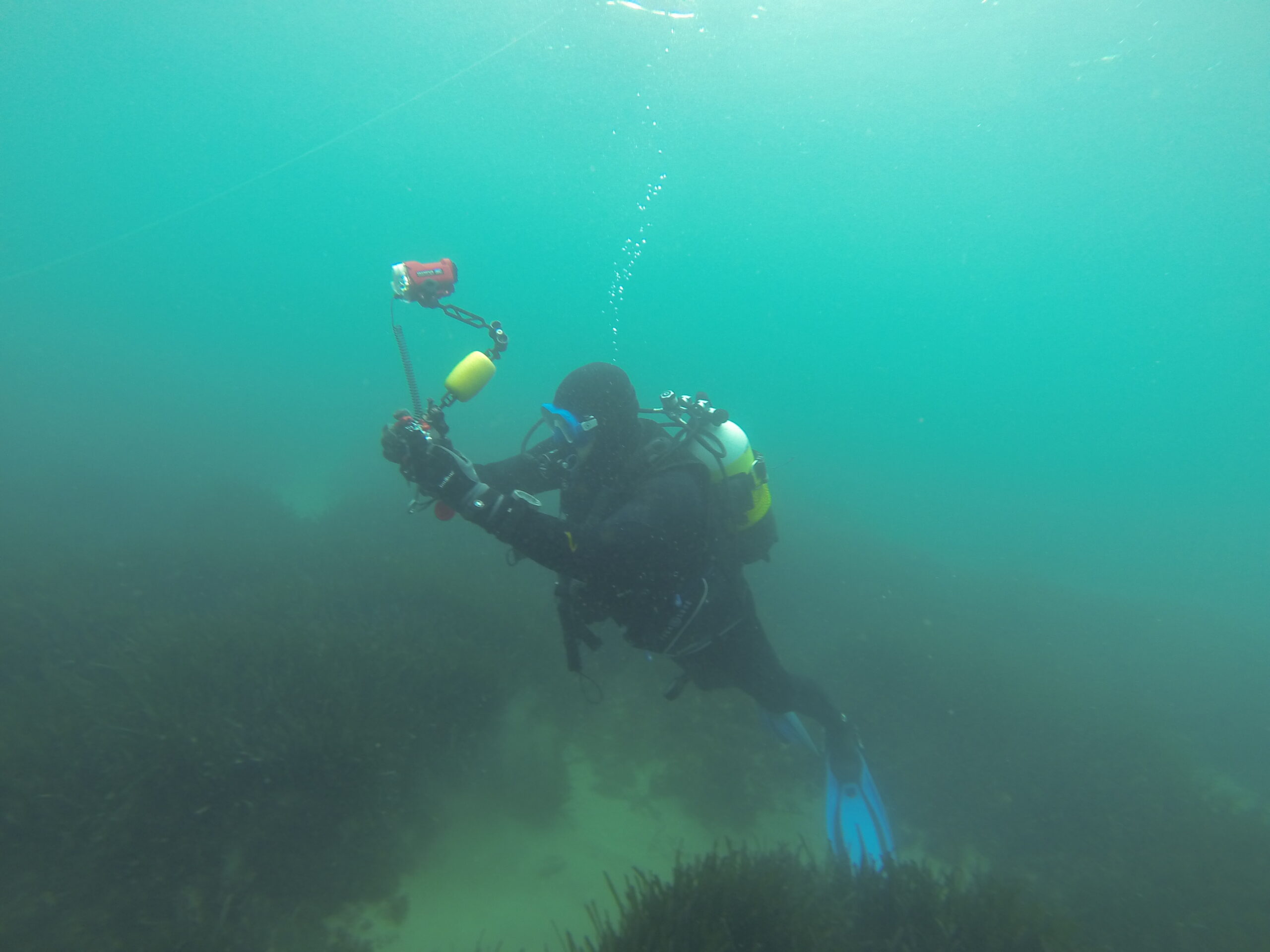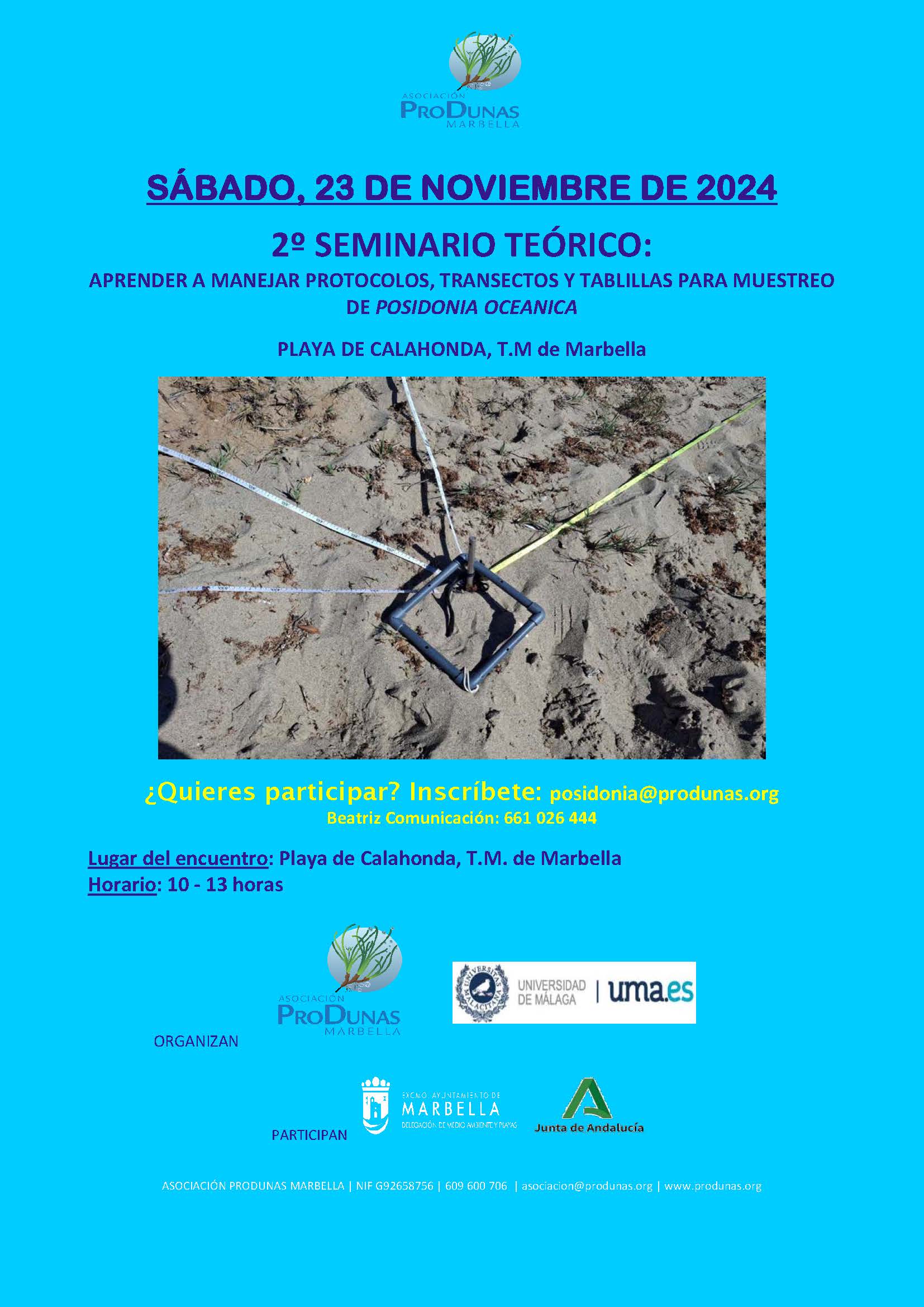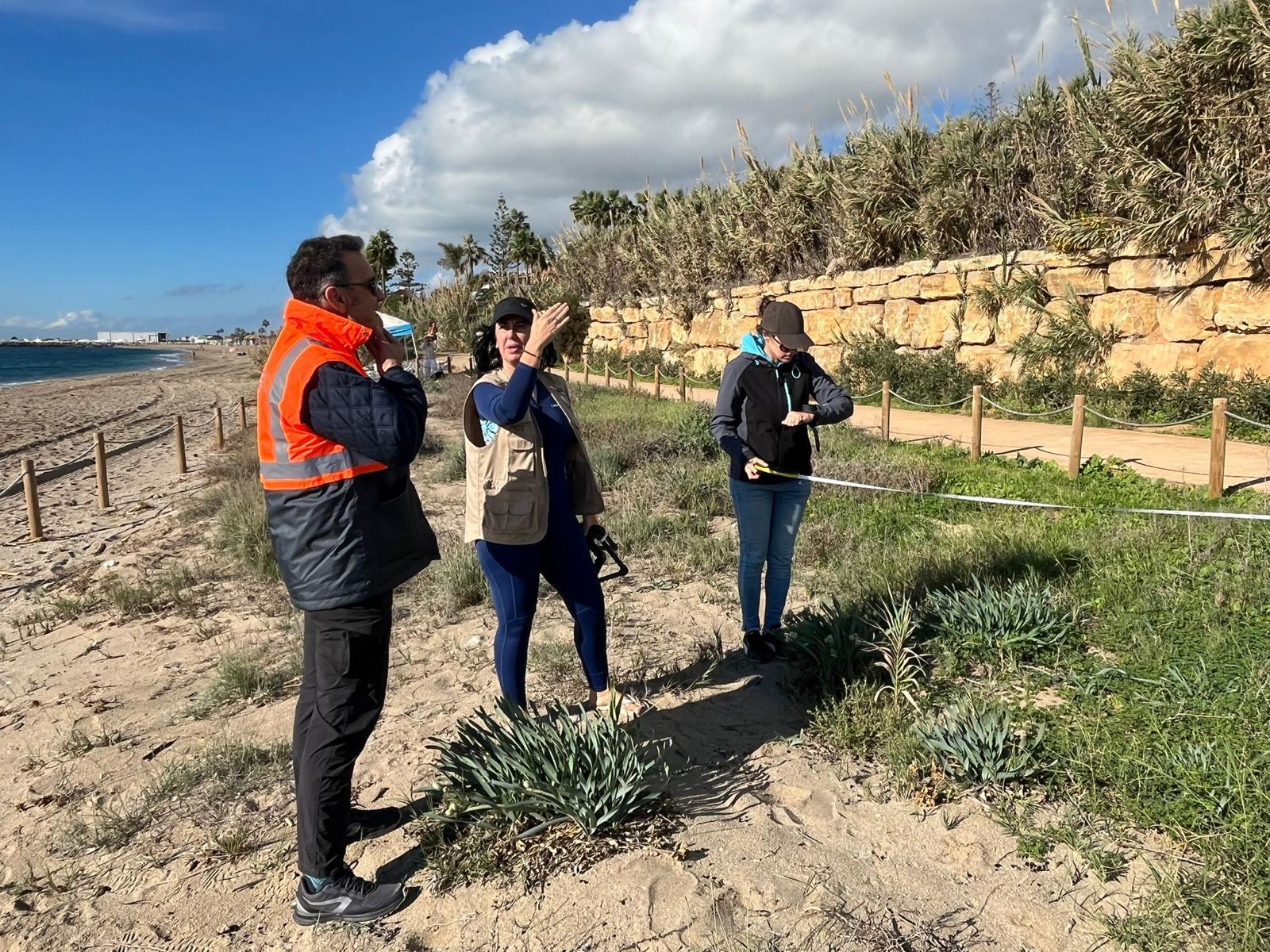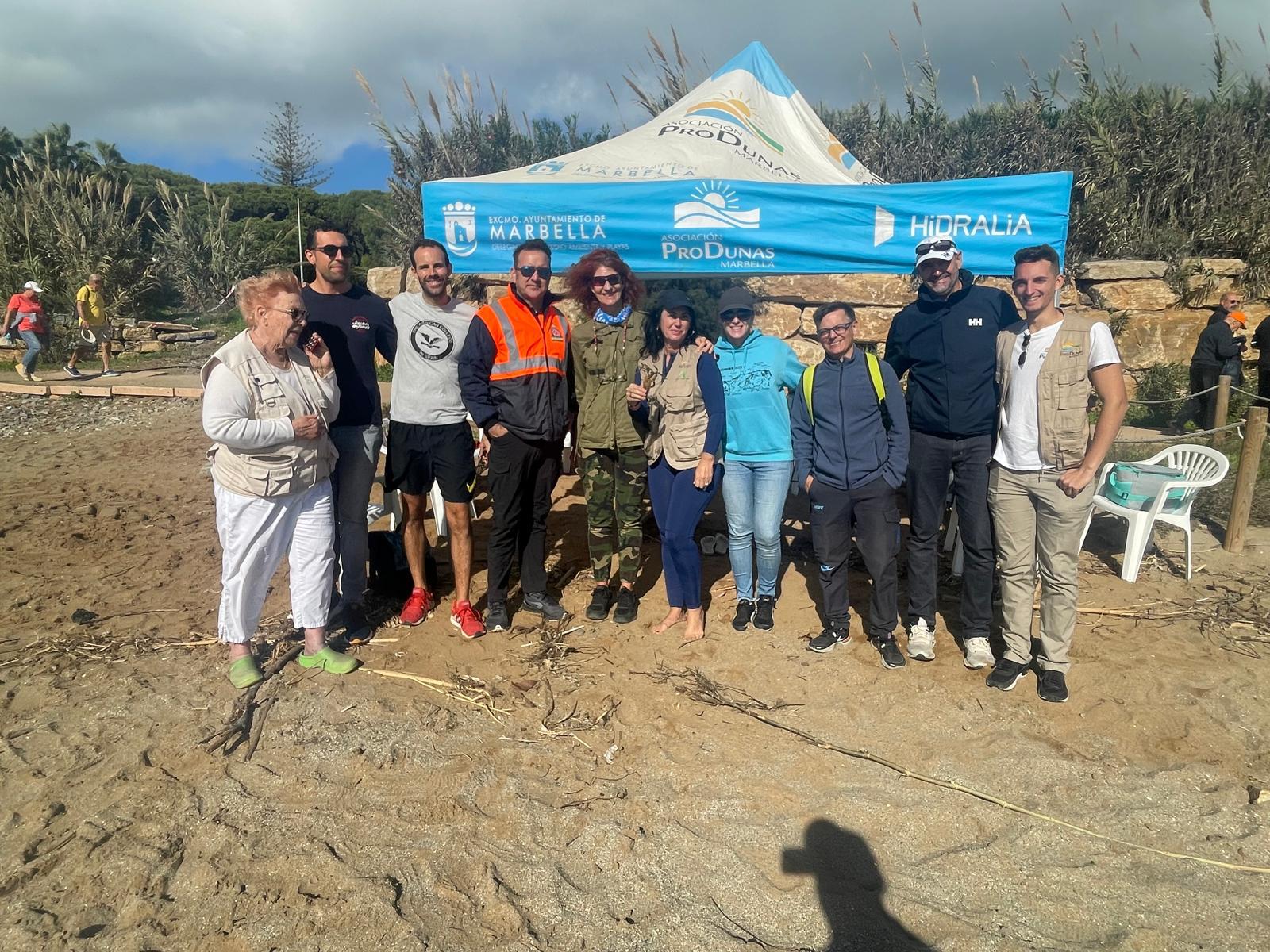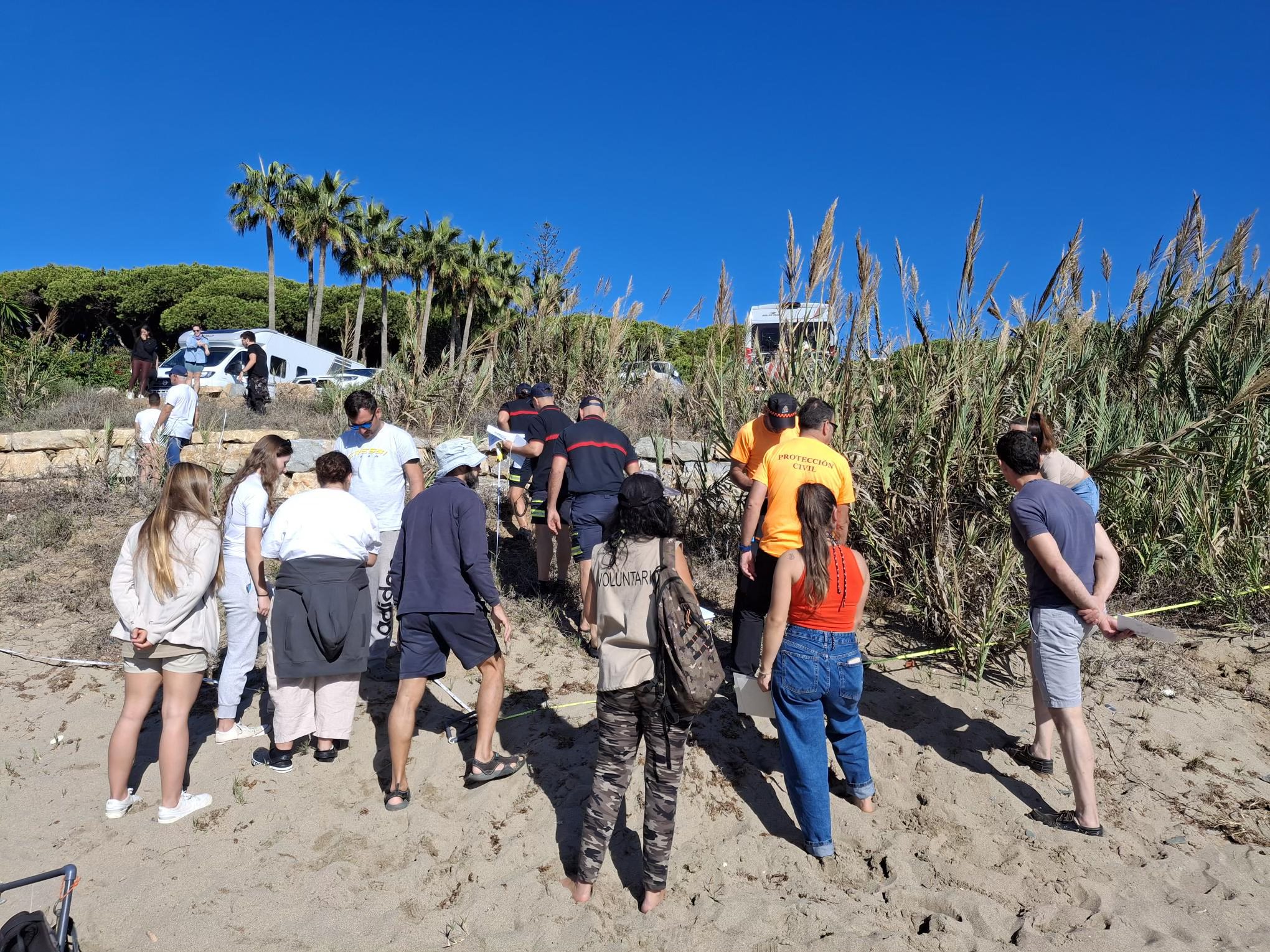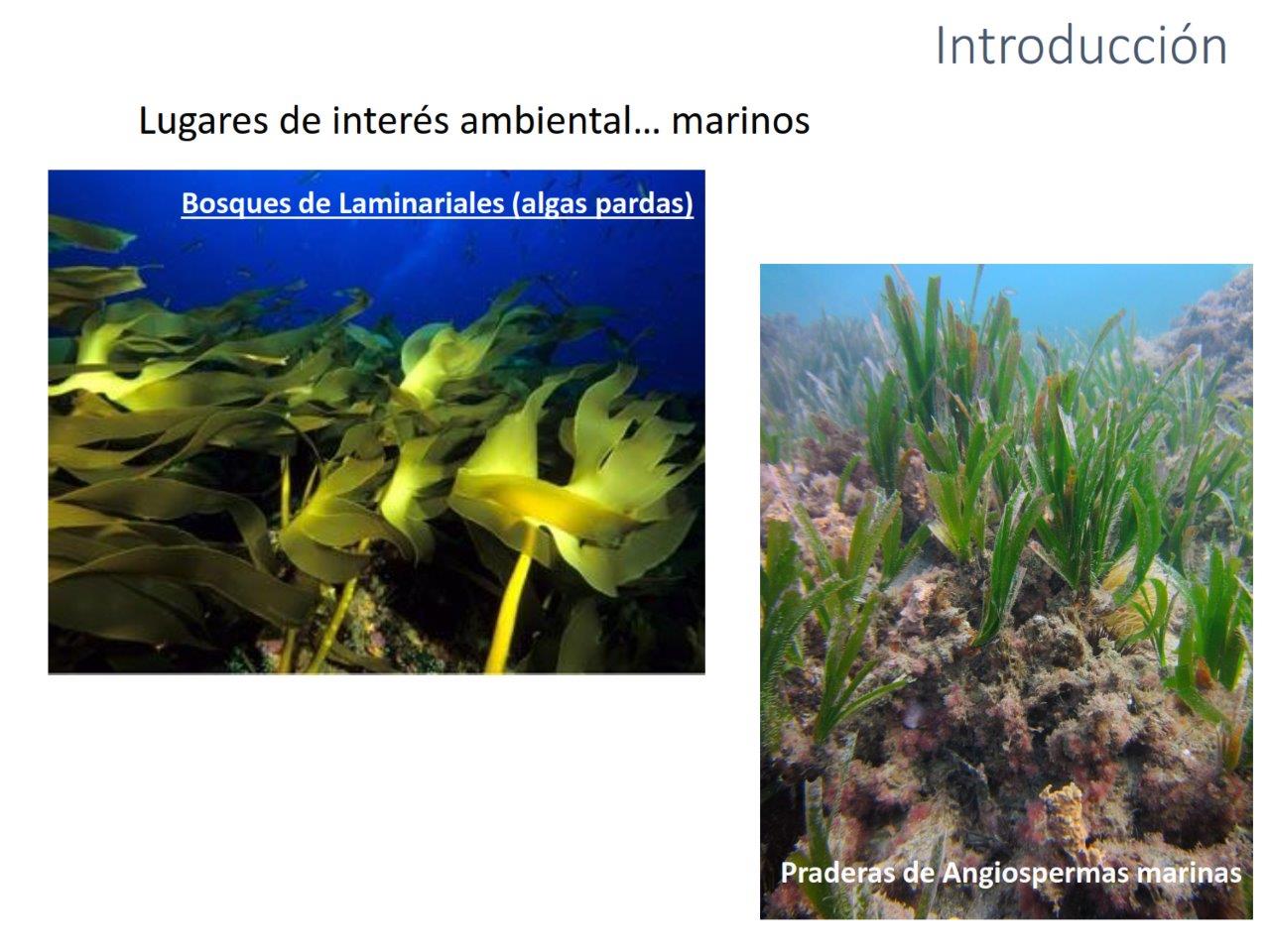December 2025 – Practical introduction with dives at POSIMED Station POS_39
The POSIMED Station POS_39 has already been installed by the Regional Government of Andalusia in the Posidonia oceanica seagrass meadow at Torre Calahonda (Mijas). This station is part of the seagrass monitoring network and will allow the collection of regular data on the conservation status of the meadow.
ProDunas Marbella is organising a practical meeting with dives (scuba and/or freediving) with the aim of getting to know the station in situ, becoming familiar with the sampling point and carrying out the first technical checks, following the established methodology.
This activity is aimed at volunteer divers and collaborators with previous experience and will serve as an initial introduction to the station, as well as to reinforce knowledge of the site and the monitoring protocol.
Date: Saturday, 27 December 2025
Time: 10:00 a.m.
Location: Torre Calahonda
C/ Calypso, 201 – 29649 Mijas (Málaga)
The date may be adjusted depending on weather conditions.
DECEMBER 2025 – NEW POSIMED STATION INSTALLED IN CALAHONDA!
Today, the Andalusian Regional Government (Junta de Andalucía – JdA), together with ProDunas Marbella, has installed POS station 39 of the POSIMED programme in Calahonda, very close to the Torre de Calahonda, adding a new key monitoring point for tracking the condition of seagrass meadows along our coastline.
At ProDunas Marbella, we welcome this progress, which strengthens the scientific work aimed at understanding the health of species such as Posidonia oceanica and Cymodocea nodosa, both essential for biodiversity and for the natural protection of our coasts.
This new station will make it possible to obtain up-to-date and reliable data on the evolution of these marine ecosystems, true lungs of the Mediterranean.
We would like to thank the Andalusian Regional Government for the technical work carried out and reaffirm our commitment to continuing to collaborate and support initiatives that protect our marine environment.
We are pleased to share with you that this December 2025, the new POSIMED Station POS_39 will be installed — an important step forward in monitoring and protecting the seagrass meadows along our coastline.
The buoy will be installed by technicians from the Regional Government of Andalusia and the University of Málaga (UMA). ProDunas Marbella will be responsible for supervising the station, collecting data, and carrying out continuous monitoring, ensuring that this control point operates correctly and provides essential information for conservation.
Location: Torre Calahonda
C. Calypso, 201 – Mijas
Time: 10:00
We sincerely appreciate the involvement of all volunteers and organisations that make it possible to continue advancing in the protection of the marine environment.
April 2025 – Two pieces of good news for the seagrass project
1.The Posidonia oceanica patches identified in Victor’s Beach will be mapped in the next edition of the Atlas of Andalusia.
2.A new POSIMED monitoring station has been assigned to ProDunas Marbella in the Calahonda SCI, which now comes under our responsibility.
We continue moving forward, thanks to everyone’s effort.
October 2024 – A great marine conservation day!
On 18th October we held an inspiring theoretical-practical seminar as part of the Seagrass Meadows Monitoring and Study Project. With the invaluable collaboration of Dr. Elena Bañares from the University of Málaga and José Miguel Remón from the Junta de Andalucía, the participants learned how to locate Posidonia oceanica areas and how to measure them correctly.
During the seminar, the methodology needed to calculate mesocover, density of the arc and other essential parameters to guarantee the correct conservation of this species was explained in detail. This species is extremely valuable for our ecosystems. This was a training experience for all attendees!
We want to express our deepest gratitude to the Fire Department, Civil Protection, the Junta de Andalucía, the University of Málaga, and Marbella Town Hall for their assistance, involvement and continuous support for this very important project for the preservation of our coastline.
ProDunas Marbella continues to work hard in its commitment to caring for and protecting our natural environments. Let’s keep going!
NOVEMBER 2023 – We are moving forward with our seagrass project!
On 30th November ProDunas Marbella together with Dr. Elena Bañares from the Department of Botany and Plant Physiology of the University of Malaga, gave a theoretical-practical seminar to the volunteers who work with us in “the Monitoring and Study of Communities of Sea Phanerogams on the coast of Marbella”.
In this Seminar, María Morán, ProDunas Marbella’s biologist detailed the objectives and points to be followed in this project. Later, with the help of Dr. Elena Bañares and Doctoral Student África Nuñez, also from the University of Málaga, they explained the characteristics of this species (Posidonia oceanica, Zostera marina and noltii, Cymodocea nodosa) so as to identify them correctly. Emphasis was placed on differential structures related to the surfaces, the apices and edges of the leaves, the roots and the presence of rhizomes.
The protocol to follow during the monitoring dives was jointly discussed and density and coverage measurement techniques were put into practice. Furthermore it was demonstrated in this workshop how fragments of the phanerogams found on the shore can be pressed, and what to do with them if they are found, paying special attention to how these findings should be documented to create a database network to better understand in which areas there may be pockets of these sea meadows.
This seminar was essential to consolidate the knowledge of all participants in the project and the species of interest. But above all, it was of great importance to ensure that all participants understand the sampling protocol and know how to put it into practice. This is essential for data collection to be as rigorous as possible.
Our team will continue to work on this project and put into practice what we have learned so that together we can set up the initial database of the phanerogam communities on our coast.
Keep up to date by following the news on this and other projects.
JULY 2021 – WE ARE GOING TO SEARCH FOR MARINE SILT MEADOWS ON THE COAST OF THE “COSTA DEL SOL”
This is the development of a new and exciting project which we hope will improve and protect the Marbella beaches and dunes and
surroundings. This is a joint project with the University of Malaga. We are proud to be part of this scientific venture.
For months we have been preparing to get into this silent, mysterious and magical world. We are going to find out what is down in this
underwater world on the Costa del Sol and which is unknown to so many of us. We want to know if there are still seagrass meadows on our
coastline. These would be formed by marine Angiosperm (Posidonia oceanica, Cymodocea nodosa and less: Zoster marina or noltii).
We have started this interesting project: The Monitoring and Study of the Seagrass meadows with an Online Seminary given by Dr. Elena
Bañares España (Botanical Department and Plant Fisiology – University of Malaga).
During the summer months: July and August we are programming the observation phase with divings along the coast from Cabopino –
Marbella – San Pedro Alcántara – Estepona. We believe that this will be a magnificent opportunity for our sub aqua friends to take part in this
project. Everyone will have to follow the action protocols in place. This exercise will be controlled and evaluated and the results will be made
available to the various Administrative bodies (Junta de Andalucía and Marbella’s Town Hall).
At the beginning of September we will program a face-to-face seminar to be held on the beach at Cabopino, starting the Scientific Project:
Monitoring and Study of the Seagrass Meadows – its restauration and conservation
In this phase of the project, any diver who so wishes must be federated or belong to a diving Federation, as they must be familiar with the
underwater equipment. Divers from the Marbella Fire Department Sub-Aqua section as also Civil defence organization will actively take part.
We know that Posidonia (Posidonia oceanica) and the others marine angiosperms belongs to the seagrass family and that it is not a seaweed. It
is a plant, with true root structures, stems, ribbon-shaped leaves and flowers. Unlike seaweed (algae), and thanks to its roots, it is able to
attach itself to the substrates where algae cannot, such as in sedimentary or silt areas.
We also know that it plays an important role in sedimentary dynamics, as thanks to its roots it can anchor sediments. The presence of seagrass
meadows in our seas ensures the quality of the environment, the protection and shelter of many marine species in key phases of their lives.
They contribute to the richness of the infra-littoral ecosystems. The Posidonia meadows occupy large areas on the Mediterranean coast where
they play an essential role in the production of oxygen and in providing breeding grounds and refuge for many animal species.
MONITORING AND STUDY OF SILT-BASED MARINE MEADOWS OFF THE COAST OF MARBELLA (Málaga)
Most of the Seagrass meadows (Posidonia oceanica, Cymodocea nodosa, Zoster noltii) that are found on our Andalusian coasts are located in Marine Protected Areas (MPAs). In Marbella we have small nuclei of stands of these species, ‘refugees’ not under any protection framework.
We believe that the conservation and restoration of these nuclei are of vital importance since, in addition to Posedonia being an endemic species of the Mediterranean, catalogued as a threatened species on the Mediterranean red list and included in Annex II of the Habitats Directive, these areas belong to its westernmost stands in the Mediterranean. These ecosystems must be maintained to reduce the continuous loss of biodiversity its waters are suffering.
Goals:
This project pursues the following main objectives:
- Promote the conservation of biological diversity and marine ecosystems in our region, preserving species that are essential for the sustainability of these habitats in the Mediterranean.
- Encourage research, development and use of new technologies and processes, in order to mitigate the effects of the Climate Change in process.
Benefits:
The existence and, as a result, conservation of these stands of seagrass on our coast generate a series of positive factors that we must consider and preserve:
- They are a bio-indicator of good water quality. They contribute to keeping the waters crystalline thanks to their ability to extract and accumulate sediments from the sea.
- They have great influence on different ecological processes such as wave attenuation, material retention and sediment fixation; helping to mitigate the effects of the great erosion that our coastline is suffering. They manage to reduce the force of the waves, protect the coastline and help preserve the beach-dune system, contributing to the accumulation of sand particles.
- Seagrasses support commercial fisheries and biodiversity, acting as nurseries for juvenile fish and crustaceans.
- It has been estimated that the world’s seagrass meadows can capture up to 83 million metric tons of carbon each year. Seagrasses therefore are known as the “lungs of the sea”. One square meter of seagrass can generate 10 litres of oxygen every day through photosynthesis.
We suggest the project be initiated close to the Cabopino Marina. This structure, in addition to slowing down the natural dynamics of sediment in the dune ecosystem, acts as a barrier and stops the of dispersal of propagules or seeds of the Seagrass from the population found just east of the Cabopino marina, specifically in Calahonda (Mijas). There is a large stand there catalogued as a ZEC (Special Zone of Conservation) zone.
Our geographic location plays a very important role in the development of this endemic Mediterranean flowering plant. Marbella is located very close to the Strait of Gibraltar, an area where the waters from the Atlantic Ocean and the Mediterranean Sea merge. This clash of waters helps develop a slope that is gradually lost the farther east we get into the Mediterranean. In Marbella you can still appreciate the influence of the Atlantic Ocean and these environmental conditions may stop or weaken the development of these meadows in our waters.
We must also pay special attention of the currents that flow in this area which can affect the development of these seagrasses. Likewise, the storms that hit our coasts, especially in the autumn-winter seasons must be taken into account. Disturbances in the waters can prevent these meadows from developing sturdily.
The action of man in work-related activities such as fishing, trawling and shellfish fishing or sports activities such as jet skis and irresponsible diving, generate such a devastating effect on the depths that the stands of this phanerogam are depleted and their development is even impeded.
Scientific Feasibility Study:
We are conducting a detailed feasibility study for our project. We will include a viability map of the species in the area where we consider it to be more favourable for the development of the stands of the different seagrasses.
We need to evaluate the existence of all seagrasses such as Posidonia oceanica, Cymodocea nodosa, Zostera marina or Zostera noltii. For this we have consulted several valuable exhibitions prepared by international organisations. We have especially relied on the REDIAM (Environmental Information Network of Andalusia) program of the Junta de Andalucía – Ministry of Agriculture, Livestock, Fisheries and Sustainable Development, which shows the main extensions of marine phanerogams and algae of ecological interest on our coastline.
As well as relying on existing information, we want to establish in detail the state the plant stands are in on the seabed on the coast of Marbella (Malaga). We need to have our teams of divers make a detailed and reliable study of the plant communities.
Our divers will carry out these observation dives in the areas that we have highlighted as being of high favourability for a good development of seagrasses. If this proves to be so, the state of these stands will be assessed and, if they are in decline, we will study and evaluate the restoration work needed.
We will compare the stands of Posidonia oceanica found in Mijas (Málaga), declared as a ZEC zone, and the stands found both in Cabopino and in other possible centres in Marbella.
In our opinion, the investigations we are about to undertake jointly with the University of Malaga (UMA) will contribute to establishing the water quality and the state of the marine silts in terms of organic material, that is, finding out the quantity of nutrients present in these waters and on the sea floor. It is important that these soils are found to have enough organic compounds to support the correct growth and development of the seagrasses. Should these silts be poor in nutrients, the substrata could be prepared to help the development of Posidonia oceanica by planting a forerunner species, such as Cymodocea nodosa, which is another of the specific species in the formation of phanerogam meadows in the Mediterranean.
Returns to be expected:
The existence and, consequently, the conservation of these stands of Seagrass on our coasts generate a series of positive factors that we must study and preserve:
- They are a bio-indicator of good water quality. They contribute to keeping the waters crystalline thanks to their ability to store sediments from the sea.
- They have great influence on different ecological processes such as wave attenuation, material retention and sediment fixation; helping to mitigate the effects of the massive erosion that our coastline is suffering. As they reduce the force of the waves, they protect the coastline and help conserve the beach-dune system, by contributing to the retention of sand particles.
The Association works tirelessly for the defence and preservation of the unique ecosystems that survive in the natural sand dune environments in the Province of Málaga; promotes the protection of native flora and small wildlife; promotes recovery, rehabilitation and conservation of interesting biodiversity of sand dunes areas in the municipality of Marbella.





